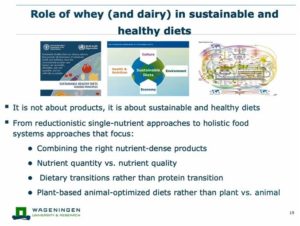Today’s third part of the 9th International Whey Conference, organized by EWPA and ADPI, focused on nutritional aspects of whey and whey derivatives. Again, the conference was organised with the support of Teagasc, the Irish Agriculture and Food Development Authority, as a physical event that was scheduled for September in Dublin had to give way to an online conference in the wake of the pandemic.

Thom Huppertz, Professor of Dairy Science and Technology at Wageningen University, advocated for a balanced diet made up from plant as well as from animal products. The only way to get to a truly sustainable food system is, according to Huppertz, to end the clash plant vs. animal. Animals can deliver one third of human protein supply without getting in competition with plant growing. If one third of the protein supply comes from animals, 25% less agricultural land is required compared to a strict plant-based diet as animals contribute to optimum land use, Huppertz said.
Dr. Esra Cakir-Fuller, Principal Research Scientist at Fonterra, advertised the advantages of micoparticulated whey protein for use in special products that help prevent malnutrition. Fonterra’s patended process delivers WPC80 containing microparticulated whey protein and can help improve the situation of malnutritioned people (mainly the elderly).
Future applications of fractionated whey proteins were the topic ofr Dr. Anand Rao, VP Ingredients and Innovation at Agropur. Out of the different fractions of whey proteins, only three are commercialised: alfa-lactalbumin, GMP (glycomacropeptide) and lactoferrin. Rao sees no imminent new applications for lactoferrin as the demand from the infant food industry is not yet saturated and only limited amounts of this protein are available. The situation is different for alfa-lactalbumin which due to its high content of tryptophane may become a means to treat epilepsy. Alfa-lactalbumin also might be used in a few years to fight cancer as it can transport activated oleic acid or gold nanoparticles right into cancer cells. Future applications for GMP may base on their anti-bacterial, anti-viral, prebiotic, re-calcification or anti-inflammatory bioactivy.
A whole series of whey proteins has not yet come under the radar of science and industry, Rao said, pointing out to beta-lactoglobuline, immune globulins or bovine serum albumine. Some of these proteins might also have characteristics making them interesting for future applications.




